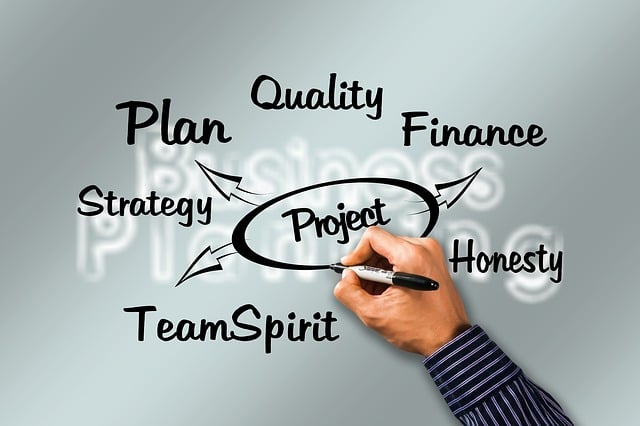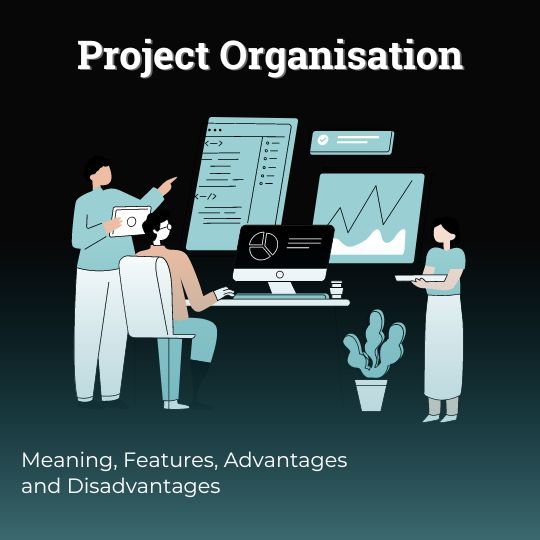Introduction to Project Organisation
Meaning, Features, Advantages and Disadvantages
In this article we will go through the topic Project Organisation: Meaning, Features, Advantages and Disadvantages.
What is Project Organisation?
Project organization refers to the structured arrangement of individuals, roles, responsibilities, and communication channels within a project. It outlines how the project team is structured, who is accountable for what tasks, and how information flows between team members and stakeholders. This organizational framework helps ensure that everyone involved in the project understands their role, responsibilities, and reporting lines, facilitating effective collaboration and project management.
In order to ensure clarity among all involved parties, a comprehensive document outlines the project’s objectives, timelines, and methodologies. The project is systematically deconstructed into smaller, manageable tasks utilizing the Work Breakdown Structure (WBS) Method. Additionally, a communication plan is devised to establish efficient channels for maintaining connectivity and facilitating updates among team members.
Features of Project Organisation:
Project Organisation comes with a set of helpful features that make running of a project smoother:
1. Clarity in Roles and Responsibilities:
In a well-organized project setup, each team member has a clearly defined role, outlining their tasks and objectives. This clarity ensures that everyone understands what they need to contribute, reducing confusion and boosting overall efficiency. When team members know exactly what’s expected of them, they can focus better on their assigned tasks, leading to smoother project progress and fewer errors or misunderstandings.
2. Centralized Leadership and Decision-Making:
The project manager holds the reins of leadership within the project organization, serving as the main authority figure. They oversee the project from start to finish and are responsible for making crucial decisions that impact its trajectory. With leadership consolidated in one person, decision-making becomes more streamlined, issues are resolved faster, and there’s a clear chain of command that promotes accountability and direction.
3. Fostering Team Collaboration:
Effective project organization fosters a collaborative team environment where individuals work together towards a common goal. Through open communication, mutual respect, and a shared commitment to success, team members build a strong sense of unity and cooperation. This collaborative spirit not only boosts morale and motivation but also encourages knowledge sharing, creative problem-solving, and the integration of diverse perspectives and expertise.
4. Communication as the Backbone to Project Organization:
Effective communication is crucial for successful project organization, serving as the backbone that sustains collaboration, coordination, and cohesion among team members. Regular and transparent communication channels ensure that everyone stays informed and aligned with the project’s goals and progress. By creating an environment where ideas can flow freely, concerns can be addressed, and challenges can be tackled together, effective communication minimizes misunderstandings, enhances teamwork, and drives overall project success.
5. Strategic Task Breakdown:
Project organization involves breaking down the project into smaller, manageable tasks using methods like the Work Breakdown Structure (WBS). This systematic approach helps to deconstruct the project’s scope and deliverables into discrete components, each with its own objectives, timelines, and dependencies. By breaking the project down into smaller units, teams can allocate resources more effectively, monitor progress more efficiently, and identify potential bottlenecks for optimization, thus improving project planning and execution.
6. Clear Accountability by Project Organisation:
Within the project organization, accountability is paramount, with each team member having clear responsibilities. By delineating roles, responsibilities, and expectations, project managers ensure that individuals understand their contributions and can be held accountable for their actions and outcomes. This clarity fosters a culture of accountability, enabling more effective performance management, risk mitigation, and decision-making throughout the project lifecycle.
7. Adaptability and Flexibility:
Effective project organization structures are adaptable and flexible, capable of accommodating changes in scope, requirements, or external factors. Whether using agile methodologies or traditional approaches, project organizations must remain responsive to evolving circumstances, adjusting strategies, processes, and resource allocations as needed to optimize outcomes. Embracing adaptability allows project organizations to navigate uncertainties, seize opportunities, and maintain momentum towards achieving objectives.
8. Focus on Goal Achievement:
Project organization centers around achieving goals, with efforts and resources directed towards realizing project objectives within established constraints. By aligning team efforts with overarching goals, project organizations ensure that activities remain purposeful and driven by a shared vision of success. This goal-oriented approach motivates team members, fosters clarity, alignment, and accountability, and ultimately delivers value to stakeholders.
9. Customer-Centric Approach:
Effective project organization often revolves around meeting the needs and expectations of stakeholders, particularly end-users or customers. By prioritizing customer requirements, preferences, and pain points, project organizations enhance satisfaction and loyalty. This customer focus informs decision-making, drives innovation, and fosters long-term relationships that contribute to project success and organizational growth.
10. Establishing Clear Timelines:
Project organization involves setting clear timelines and milestones that define the project’s start, duration, and completion. By establishing specific deadlines and milestones, project managers provide teams with a sense of direction and urgency, facilitating effective planning, scheduling, and resource allocation. Clear timelines enable stakeholders to monitor progress, identify potential delays, and make informed decisions to keep the project on track and within scope.

Advantages of Project Organization
1. Goal Alignment:
Project organization brings together a dedicated team with a unified focus on achieving specific objectives. By rallying behind a shared purpose, team members can channel their efforts towards a common goal without getting sidetracked by competing priorities or distractions.
2. Enhanced Efficiency by Project Organization:
Within a well-structured project organization, roles and responsibilities are clearly defined, allowing team members to work with precision and effectiveness. This clarity helps streamline workflows, minimize duplication of efforts, and prevent tasks from slipping through the cracks, ultimately leading to greater productivity and efficiency.
3. Improved Collaboration and Communication:
Effective communication lies at the heart of successful project organization. Through robust communication plans and channels, team members can collaborate seamlessly, exchange ideas, share updates, and address challenges in a timely manner. This open dialogue fosters a culture of transparency, trust, and synergy, driving collective progress towards project milestones.
4. Accountability:
Clear role delineation ensures that every team member understands their individual responsibilities and contributions to the project. With accountability firmly established, team members are empowered to take ownership of their tasks and deliverables, while the project manager provides oversight and guidance to ensure alignment with project objectives.
5. Flexibility:
Project organization is adaptable to different management methodologies and approaches, allowing teams to tailor their strategies to suit the unique requirements of each project. Whether adopting agile principles for iterative development or adhering to traditional waterfall methods for sequential execution, project organization provides the flexibility to adapt and evolve as needed to deliver successful outcomes.
6. Proactive Problem Management:
The structured framework of project organization enables teams to anticipate and address potential challenges before they escalate into larger issues. By conducting thorough risk assessments, implementing contingency plans, and fostering a proactive mindset, project managers and team members can effectively mitigate risks and overcome obstacles as they arise, ensuring smooth project progression.
7. Customer Satisfaction:
At its core, project organization is centered around meeting customer needs and delivering value. By aligning project goals with client expectations, project organizations can ensure that the final deliverables meet or exceed customer requirements, leading to high levels of satisfaction and long-term client relationships.
8. Encouragement of Innovation:
The collaborative nature of project organization encourages the exchange of diverse perspectives, ideas, and approaches. By harnessing the collective expertise and creativity of team members from different backgrounds and disciplines, project organizations can generate innovative solutions to complex problems, driving continuous improvement and competitive advantage.
9. Professional Development:
Engaging in project work provides valuable opportunities for team members to expand their skill sets, gain hands-on experience, and develop professionally. Through exposure to new challenges, responsibilities, and learning opportunities, project organization fosters individual growth and career advancement, enriching the talent pool within the organization.
10. Clarity of Objectives:
Project organization establishes clear timelines, milestones, and deliverables, providing a roadmap for all stakeholders involved. By defining project scope, goals, and timelines upfront, project organizations ensure that everyone is aligned towards a common purpose and understands their role in achieving project success. This clarity of objectives fosters motivation, focus, and commitment, driving the project forward towards successful completion.
Read Also : Types of project Management
Disadvantages of Project Organization:
1. Resource Sharing:
Projects often compete for limited resources such as personnel, equipment, and funding, leading to conflicts and inefficiencies, especially in organizations managing multiple projects simultaneously.
2. Conflict Resolution:
Team members may find themselves torn between reporting to their regular manager and the project manager, resulting in conflicts of interest and disagreements over priorities and decision-making.
3. Teamwork Challenges:
Collaboration within project teams can be challenging, particularly if team members come from different departments or lack prior experience working together, leading to communication breakdowns and interpersonal conflicts.
4. Knowledge Loss:
When projects conclude, teams disband, risking the loss of valuable knowledge and expertise gained during the project’s execution, hindering organizational learning and future project success.
5. Career Uncertainty:
Individuals working in project-based organizations may experience uncertainty about their career progression once a project concludes, leading to job insecurity and dissatisfaction.
6. Dependence on Leadership:
The success of a project often hinges on the competency and stability of the project manager. Ineffective leadership or sudden departures can disrupt project momentum and jeopardize outcomes.
7. Project Tunnel Vision:
Intense focus on project deliverables may cause team members to lose sight of broader organizational goals and strategic priorities, resulting in misalignment and missed opportunities.
8. Ambiguity in Authority:
Ambiguous lines of authority and responsibility within project organizations can lead to confusion, inefficiencies, and power struggles among team members, hindering progress and decision-making.
9. Budget Overruns:
Unforeseen challenges, scope changes, and mismanagement may cause projects to exceed their budgetary allocations, leading to financial strain and resource constraints for the organization.
10. Deadline Pressure :
The emphasis on meeting project deadlines can create a stressful work environment, contributing to burnout, decreased morale, and compromised quality of work.
Conclusion to Project Organisation:
project organization serves as a valuable framework for managing complex endeavors, offering a structured approach to goal achievement and resource allocation. While it provides numerous benefits such as clarity of roles, enhanced communication, and focused goal attainment, it also presents challenges like resource conflicts, leadership dependencies, and deadline pressures.
Navigating these challenges requires careful consideration of organizational dynamics, effective communication strategies, and proactive problem-solving approaches. By fostering a collaborative and adaptive environment, project organizations can leverage the strengths of their teams while mitigating potential drawbacks.
Ultimately, the success of project organization hinges on striking a balance between structure and flexibility, leadership and teamwork, and short-term objectives and long-term goals. Through continuous learning, adaptation, and a commitment to excellence, project organizations can achieve remarkable outcomes while ensuring the satisfaction of stakeholders and the continued growth of the organization as a whole.


One thought on “Project Organisation”